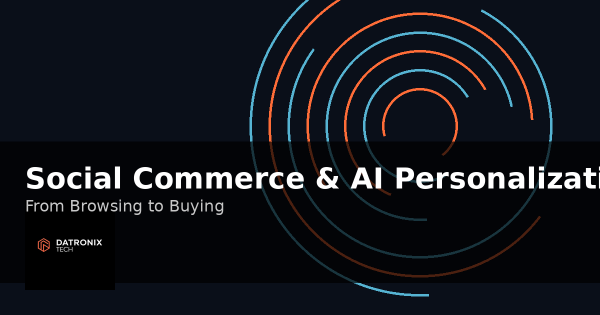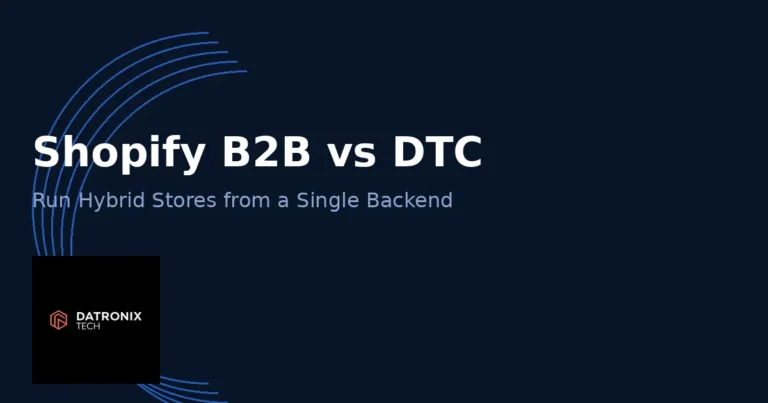Online shopping has always been about convenience – but in 2025 it’s becoming seamless. Consumers now jump straight from scrolling their favourite social feeds to completing a purchase, never visiting a traditional storefront. At the same time, artificial intelligence (AI) is making those shopping experiences feel tailor‑made for each visitor. When these two forces converge, they transform how brands build their audiences and convert browsers into buyers. This article explores how social commerce and AI‑powered personalisation are reshaping Shopify stores, the benefits and challenges they bring and practical steps to get ahead of the curve.
What Is Social Commerce?
Social commerce refers to shopping experiences embedded directly within social media platforms. Instead of clicking a link and leaving the app, shoppers can discover products, add items to their cart and check out on the same screen. In 2025 this model isn’t niche; it’s mainstream. Industry forecasts suggest that social commerce will account for about 17 % of all global ecommerce sales. Platforms like Instagram Shopping, Facebook Marketplace and TikTok Shop are leading the way, letting businesses display products in shoppable posts, stories and live streams. Brands can tag products within Reels or Lives and allow viewers to buy with a tap.
Shopify makes social commerce easy through built‑in sales channels. Merchants can connect their catalogues to Facebook, Instagram and TikTok, manage orders from their Shopify admin and synchronise inventory automatically. Combined with Shopify’s secure checkout and payment processing, social commerce brings products to wherever your audience spends its time.
The Rise of AI‑Powered Personalisation
Personalisation isn’t new, but AI takes it from superficial to predictive. According to EComposer, AI personalisation analyses customer behaviours, preferences and data patterns in real‑time to deliver customised shopping experiences. Traditional rule‑based approaches might show the same recommendations to everyone in a demographic; AI uses machine learning, predictive analytics and behavioural targeting to anticipate what each customer wants. In practice, AI delivers one‑to‑one experiences at scale: product recommendations, customised search results, dynamic pricing and even personalised story content.
AI systems typically follow a four‑stage process:
Data collection: They gather browsing history, search queries, cart activity, past purchases, email engagement and session duration across touchpoints.
Pattern recognition: Machine‑learning algorithms identify trends (e.g., a shopper favouring neutral colours or weekend promotions).
Segmentation and predictive modelling: Customers are dynamically grouped, and predictive analytics estimate which actions they’re likely to take next – such as abandoning a cart or reacting to a discount.
Personalised delivery and real‑time adaptation: Based on predictions, AI presents tailored content like product suggestions, promotions or emails and updates experiences as behaviours change.
This shift has meaningful outcomes. Personalised experiences powered by AI have been shown to improve conversion rates and customer lifetime value while reducing acquisition costs. Brands that adopt AI personalisation see customers staying loyal and spending more because the shopping journey feels relevant to them.
Why Social Commerce and AI Personalisation Matter Together
These trends aren’t isolated – they reinforce each other. Social networks supply the discovery and community component; AI personalisation provides the relevance. A customer may watch a TikTok influencer review a product, tap the tag, and go straight to checkout. Meanwhile, AI is tailoring the next recommendation based on that user’s preferences. When done well, shoppers feel like the product was made for them, and the transition from discovery to purchase is frictionless.
For Shopify merchants, combining social commerce with AI personalisation means:
Shorter funnels: Customers see your product in context, get personalised messaging and purchase without leaving their feed.
Higher conversion rates: Predictive recommendations and personalised offers reduce drop‑off at every stage.
Greater lifetime value: When shoppers feel understood and valued, they return more often and spend more.
Stronger data: Each interaction across social channels feeds back into your AI models, improving accuracy over time.
Examples of AI Personalisation on Shopify
Shopify’s App Store offers a variety of tools to help merchants implement AI‑driven personalisation. Here are a few categories and examples to consider:
Product recommendation engines
Apps like Nosto, Rebuy and Wiser analyse browsing behaviour and purchase history to show customers relevant products in real time. According to InteractOne, AI tools analysing customer behaviour and providing real‑time product recommendations boost engagement and conversion rates. These platforms often include cross‑sell and upsell widgets for cart pages and checkout.
Chatbots and conversational AI
Tools such as Gorgias, Chatty AI Chatbot & Live Chat and Tidio deliver personalised customer service 24/7. AI‑powered chatbots enhance real‑time interactions, offering product suggestions and support that mimic human conversation.
Email and SMS personalisation
Marketing apps like Klaviyo, Omnisend and Personalize WP (a WordPress/Shopify integration) segment audiences and send targeted messages based on behaviour and purchase history. Predictive analytics can suggest send times, subject lines and content that resonate best..
AI search and navigation
On‑site search tools such as Searchspring and Algolia use natural language processing and AI to interpret search intent and return relevant results. They adapt as customers interact, improving both search accuracy and product discovery.
How to Integrate Social Commerce into Your Shopify Store
Connect social sales channels: In your Shopify admin, add Facebook, Instagram, TikTok, Pinterest and other social channels. Sync your product catalogue to ensure pricing and inventory stay consistent across platforms.
Create shoppable content: Use product tagging in Instagram Reels, stories and posts; schedule Facebook Live or TikTok Shop events; and embed product links in influencer collaborations. Social commerce features like Instagram Shopping and TikTok Shop let audiences buy without leaving the app.
Partner with influencers and creators: Social commerce thrives on trust. Micro‑ and nano‑influencers offer high engagement at lower cost than celebrity endorsements. They can co‑create content that highlights your products authentically.
Monitor analytics: Use Shopify’s analytics and platform-specific reporting to track sales from social channels. Evaluate which content drives the most clicks, adds to cart and conversions, then adjust accordingly.
Best Practices for AI‑Driven Personalisation
Collect clean, consented data: Ensure compliance with privacy laws (e.g., GDPR/CCPA) and be transparent about data usage. The quality of personalisation depends on the data you gather.
Segment and test: Divide users into meaningful segments and A/B test different recommendations and offers. AI doesn’t replace experimentation; it amplifies your insights.
Start with quick wins: Implement product recommendation widgets or an AI chatbot first. Tools like Nosto or Chatty AI Chatbot can show immediate results in engagement and revenue.
Personalise across the funnel: Don’t limit personalisation to the product page. Customise search results, navigation, cart suggestions and post‑purchase emails.
Monitor and refine: Review performance dashboards in your AI tools regularly. Adjust rules or weightings to improve accuracy and avoid over‑personalisation that might feel intrusive.
Putting It All Together: From Browsing to Buying
To capitalise on the confluence of social commerce and AI personalisation, Shopify merchants should aim for a cohesive strategy:
Unify your brand across channels: Use consistent visuals, messaging and tone across Instagram, TikTok, Facebook and your website. Make it clear that the shopping experience will be seamless, whether a customer buys through a social post or directly on your site.
Create engaging stories: Use short‑form video and live streams to showcase products in use. Pair these with AI‑generated subtitles, captions and real-time recommendations for viewers. Social commerce thrives on authenticity, so encourage user‑generated content.
Leverage predictive analytics: Use AI tools to identify which social campaigns drive high‑value traffic and adjust ad spend accordingly. Predictive models can help determine when to retarget and what promotions will convert hesitant buyers.
Deliver personalised follow‑ups: After a purchase via a social channel, send personalised confirmation emails, dynamic upsell offers and tailored loyalty rewards. AI‑driven email marketing ensures your messages stay relevant.
Conclusion
The distinction between browsing and buying is fading. Social media channels are becoming shopping malls, and AI personalisation is tailoring every aisle to each visitor. For Shopify merchants, this convergence offers both opportunity and challenge. Done right, it can shorten the path to purchase, deepen customer relationships and drive significant revenue growth. As these trends continue, staying ahead will require experimenting with new social commerce features, investing in AI-driven personalisation and continuously refining your strategy.
At Datronix Tech, we help businesses navigate the evolving landscape of ecommerce. Whether you need to integrate social channels into your Shopify store or deploy AI personalisation tools that convert more visitors, our team can guide you from strategy to execution. Contact us today to turn browsers into buyers and build a store ready for the future.
FAQs
Q1. What is social commerce?
Social commerce is the practice of selling products directly on social media platforms like Instagram, Facebook and TikTok. Users can discover, browse and buy without leaving the app, creating a seamless shopping experience.
Q2. How does AI personalisation work in ecommerce?
AI personalisation analyses customer data (browsing, purchase history, interactions) with machine learning and predictive analytics. It then delivers personalised recommendations and content in real time based on that user’s preferences and behaviour.
Q3. Why are AI chatbots important for Shopify?
Chatbots like Chatty AI and Gorgias provide immediate, personalised responses to customer queries. They can answer questions, recommend products and guide shoppers through checkout, improving conversion rates and customer satisfaction.
Q4. What’s the first step to using AI personalisation on Shopify?
Start by selecting an app that fits your needs, such as a recommendation engine or chatbot. Implement one tool at a time, set up tracking and measure its impact on key metrics like average order value and conversion rate.





